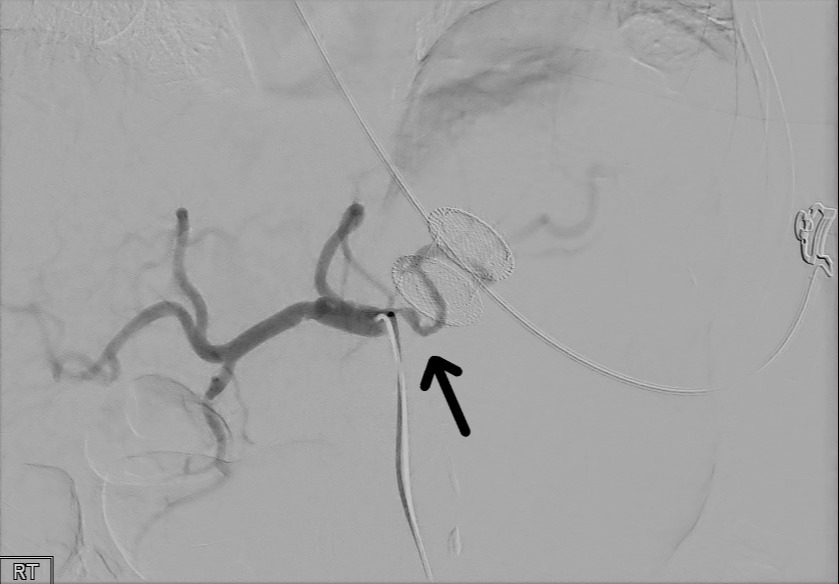Back
Poster Session D - Tuesday Morning
Category: Interventional Endoscopy
D0451 - Gastrointestinal Bleeding Secondary to Splenic Artery Aneurysm: A Delayed Complication of a Lumen Apposing Metal Stent
Tuesday, October 25, 2022
10:00 AM – 12:00 PM ET
Location: Crown Ballroom

Umair Iqbal, MD, CNSC
Geisinger Medical Center
Danville, Pennsylvania
Presenting Author(s)
Umair Iqbal, MD, CNSC1, Harshit S. Khara, MD, FACG2, David L. Diehl, MD1, Nicholas Montecalvo, MD1, Bradley D. Confer, DO1
1Geisinger Medical Center, Danville, PA; 2Geisinger Health System, Danville, PA
Introduction: Lumen apposing metal stents (LAMS) have been widely used for drainage of peri-pancreatic collections. Pseudoaneurysm formation and rupture is an uncommon complication of LAMS. A possible mechanism for bleeding with current LAMS is its bi-flanged design which does not allow mobility of walls or the stent when the size of collection reduces in size post drainage. This can theoretically cause tension over the wall and surrounding vasculature which lead to pseudoaneurysm formation and bleeding.
Case Description/Methods: A 71-year-old female with a history of necrotizing pancreatitis complicated by splenic vein thrombosis on warfarin underwent LAMS placement with a significant reduction in the peri-pancreatic collection on follow up imaging. Three months later, she presented with two days of melena and hematochezia. On evaluation, she was hypotensive and tachycardic. Lab work revealed hemoglobin of 6.1 g/dl from a baseline of 12 g/dl. A computerized tomography angiography (CTA) which did not show active GI bleeding. EGD showed a large pulsating non-bleeding vessel within LAMS. Due to the potential of increasing bleeding with the removal of LAMS, a mesenteric angiogram was done demonstrating a splenic artery pseudoaneurysm, and this was successfully embolized with coils. She subsequently underwent repeat EGD following the coiling with successful removal of LAMS. No further bleeding followed stent removal.
Discussion: A ruptured pseudoaneurysm can present with abdominal pain, signs of GI bleeding, or hemobilia. CTA is an important diagnostic step but can be unremarkable such as in this case. Pseudoaneurysm formation can be prevented with timely removal of LAMS after the successful drainage and reduction in the size of the pancreatic collection Empiric embolization before removal of LAMS can prevent life-threatening bleeding, and therefore discussion with the interventional radiologist should be done before attempting removal of LAMS in such high-risk cases. Although GI bleeding secondary to rupture pseudoaneurysm with LAMS is a rare complication, it should be considered in patients with recent LAMS placement who present with GI bleeding.

Disclosures:
Umair Iqbal, MD, CNSC1, Harshit S. Khara, MD, FACG2, David L. Diehl, MD1, Nicholas Montecalvo, MD1, Bradley D. Confer, DO1. D0451 - Gastrointestinal Bleeding Secondary to Splenic Artery Aneurysm: A Delayed Complication of a Lumen Apposing Metal Stent, ACG 2022 Annual Scientific Meeting Abstracts. Charlotte, NC: American College of Gastroenterology.
1Geisinger Medical Center, Danville, PA; 2Geisinger Health System, Danville, PA
Introduction: Lumen apposing metal stents (LAMS) have been widely used for drainage of peri-pancreatic collections. Pseudoaneurysm formation and rupture is an uncommon complication of LAMS. A possible mechanism for bleeding with current LAMS is its bi-flanged design which does not allow mobility of walls or the stent when the size of collection reduces in size post drainage. This can theoretically cause tension over the wall and surrounding vasculature which lead to pseudoaneurysm formation and bleeding.
Case Description/Methods: A 71-year-old female with a history of necrotizing pancreatitis complicated by splenic vein thrombosis on warfarin underwent LAMS placement with a significant reduction in the peri-pancreatic collection on follow up imaging. Three months later, she presented with two days of melena and hematochezia. On evaluation, she was hypotensive and tachycardic. Lab work revealed hemoglobin of 6.1 g/dl from a baseline of 12 g/dl. A computerized tomography angiography (CTA) which did not show active GI bleeding. EGD showed a large pulsating non-bleeding vessel within LAMS. Due to the potential of increasing bleeding with the removal of LAMS, a mesenteric angiogram was done demonstrating a splenic artery pseudoaneurysm, and this was successfully embolized with coils. She subsequently underwent repeat EGD following the coiling with successful removal of LAMS. No further bleeding followed stent removal.
Discussion: A ruptured pseudoaneurysm can present with abdominal pain, signs of GI bleeding, or hemobilia. CTA is an important diagnostic step but can be unremarkable such as in this case. Pseudoaneurysm formation can be prevented with timely removal of LAMS after the successful drainage and reduction in the size of the pancreatic collection Empiric embolization before removal of LAMS can prevent life-threatening bleeding, and therefore discussion with the interventional radiologist should be done before attempting removal of LAMS in such high-risk cases. Although GI bleeding secondary to rupture pseudoaneurysm with LAMS is a rare complication, it should be considered in patients with recent LAMS placement who present with GI bleeding.

Figure: Digital subtraction angiogram of the Celiac artery demonstrating luminal irregularity and dilation, consistent with pseudoaneurysm of the main Splenic artery, about the inferior margin of the AXIOS stent
Disclosures:
Umair Iqbal indicated no relevant financial relationships.
Harshit Khara indicated no relevant financial relationships.
David Diehl: Acutuated Medical – Advisor or Review Panel Member. Boston Scientific – Advisor or Review Panel Member. Castle Biosciences – Advisor or Review Panel Member. GI-Supply – Advisor or Review Panel Member. Kite Endoscopic Innovations – Advisor or Review Panel Member. Lumendi – Advisor or Review Panel Member. Merit Medical – Advisor or Review Panel Member. Microtech – Advisor or Review Panel Member. Olympus – Advisor or Review Panel Member. One Pass Medical – Advisor or Review Panel Member. Pentax – Advisor or Review Panel Member. Steris – Advisor or Review Panel Member.
Nicholas Montecalvo indicated no relevant financial relationships.
Bradley Confer indicated no relevant financial relationships.
Umair Iqbal, MD, CNSC1, Harshit S. Khara, MD, FACG2, David L. Diehl, MD1, Nicholas Montecalvo, MD1, Bradley D. Confer, DO1. D0451 - Gastrointestinal Bleeding Secondary to Splenic Artery Aneurysm: A Delayed Complication of a Lumen Apposing Metal Stent, ACG 2022 Annual Scientific Meeting Abstracts. Charlotte, NC: American College of Gastroenterology.
